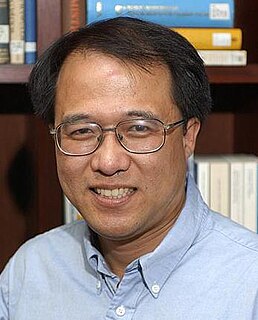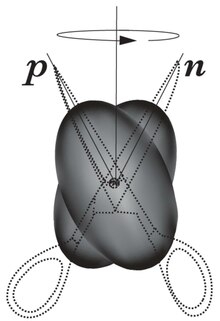Related Research Articles
The λ (lambda) universality class is a group in condensed matter physics. It regroups several systems possessing strong analogies, namely, superfluids, superconductors and smectics. All these systems are expected to belong to the same universality class for the thermodynamic critical properties of the phase transition. While these systems are quite different at the first glance, they all are described by similar formalisms and their typical phase diagrams are identical.

Mott insulators are a class of materials that are expected to conduct electricity as predicted by conventional band theories, but these compounds turn out to be insulators. These insulators failed to be correctly described by band theories of solids due to strong electron–electron interactions, which are not considered in conventional band theory. Mott transition is a transition from a metal to an insulator, driven by the strong interactions between electrons. One of the simplest models that can capture Mott transition is Hubbard model.

In physics, topological order is a kind of order in the zero-temperature phase of matter. Macroscopically, topological order is defined and described by robust ground state degeneracy and quantized non-Abelian geometric phases of degenerate ground states. Microscopically, topological orders correspond to patterns of long-range quantum entanglement. States with different topological orders cannot change into each other without a phase transition.
Oleg Sushkov is a professor at the University of New South Wales and a leader in the field of high temperature super-conductors. Educated in Russia in quantum mechanics and nuclear physics, he now teaches in Australia.
Jozef T. Devreese is a Belgian scientist, with a long career in condensed matter physics. He is Professor Emeritus of Theoretical Physics at the University of Antwerp.

Ofer Biham is a faculty member at The Racah Institute of Physics of the Hebrew University of Jerusalem in Israel. Biham received his Ph.D. for research on quasiperiodic systems at the Weizmann Institute of Science in 1988, under the supervision of David Mukamel.

In condensed matter physics, a string-net is an extended object whose collective behavior has been proposed as a physical mechanism for topological order by Michael A. Levin and Xiao-Gang Wen. A particular string-net model may involve only closed loops; or networks of oriented, labeled strings obeying branching rules given by some gauge group; or still more general networks.
The topological entanglement entropy or topological entropy, usually denoted by , is a number characterizing many-body states that possess topological order.

Xiao-Gang Wen is a Chinese-American physicist. He is a Cecil and Ida Green Professor of Physics at the Massachusetts Institute of Technology and Distinguished Visiting Research Chair at the Perimeter Institute for Theoretical Physics. His expertise is in condensed matter theory in strongly correlated electronic systems. In Oct. 2016, he was awarded the Oliver E. Buckley Condensed Matter Prize.

David Matthew Ceperley is a theoretical physicist in the physics department at the University of Illinois Urbana-Champaign or UIUC. He is a world expert in the area of Quantum Monte Carlo computations, a method of calculation that is generally recognised to provide accurate quantitative results for many-body problems described by quantum mechanics.
Subir Sachdev is Herchel Smith Professor of Physics at Harvard University specializing in condensed matter. He was elected to the U.S. National Academy of Sciences in 2014, and received the Lars Onsager Prize from the American Physical Society and the Dirac Medal from the ICTP in 2018. He was a co-editor of the Annual Review of Condensed Matter Physics from 2017-2019.

A topological insulator is a material that behaves as an insulator in its interior but whose surface contains conducting states, meaning that electrons can only move along the surface of the material. Topological insulators have non-trivial symmetry-protected topological order; however, having a conducting surface is not unique to topological insulators, since ordinary band insulators can also support conductive surface states. What is special about topological insulators is that their surface states are symmetry-protected Dirac fermions by particle number conservation and time-reversal symmetry. In two-dimensional (2D) systems, this ordering is analogous to a conventional electron gas subject to a strong external magnetic field causing electronic excitation gap in the sample bulk and metallic conduction at the boundaries or surfaces.
Daniel L. Stein is an American physicist and Professor of Physics and Mathematics at New York University. From 2006-2012 he served as the NYU Dean of Science.

David R. Nelson is an American physicist, and Arthur K. Solomon Professor of Biophysics, at Harvard University.
The toric code is a topological quantum error correcting code, and an example of a stabilizer code, defined on a two-dimensional spin lattice It is the simplest and most well studied of the quantum double models. It is also the simplest example of topological order—Z2 topological order (first studied in the context of Z2 spin liquid in 1991). The toric code can also be considered to be a Z2 lattice gauge theory in a particular limit. It was introduced by Alexei Kitaev.
In condensed matter physics, a quantum spin liquid is a phase of matter that can be formed by interacting quantum spins in certain magnetic materials. Quantum spin liquids (QSL) are generally characterized by their long-range quantum entanglement, fractionalized excitations, and absence of ordinary magnetic order.
In quantum many-body physics, topological degeneracy is a phenomenon in which the ground state of a gapped many-body Hamiltonian becomes degenerate in the limit of large system size such that the degeneracy cannot be lifted by any local perturbations.
Tilman Esslinger is a German experimental physicist. He is Professor at ETH Zurich, Switzerland, and works in the field of ultracold quantum gases and optical lattices.

Scissors Modes are collective excitations in which two particle systems move with respect to each other conserving their shape. For the first time they were predicted to occur in deformed atomic nuclei by N. LoIudice and F. Palumbo, who used a semiclassical Two Rotor Model, whose solution required a realization of the O(4) algebra that was not known in mathematics. In this model protons and neutrons were assumed to form two interacting rotors to be identified with the blades of scissors. Their relative motion (Fig.1) generates a magnetic dipole moment whose coupling with the electromagnetic field provides the signature of the mode.
James (Jim) P. Eisenstein is the Frank J. Roshek Professor of Physics and Applied Physics at the physics department of California Institute of Technology.
References
Exact solution for classical dimer models on planar graphs:
- Kasteleyn, P.W. (1961). "The statistics of dimers on a lattice". Physica. Elsevier BV. 27 (12): 1209–1225. Bibcode:1961Phy....27.1209K. doi:10.1016/0031-8914(61)90063-5. ISSN 0031-8914.
- Fisher, Michael E. (15 December 1961). "Statistical Mechanics of Dimers on a Plane Lattice". Physical Review. American Physical Society (APS). 124 (6): 1664–1672. Bibcode:1961PhRv..124.1664F. doi:10.1103/physrev.124.1664. ISSN 0031-899X.
Introduction of model; early literature:
- Kivelson, Steven A.; Rokhsar, Daniel S.; Sethna, James P. (1 May 1987). "Topology of the resonating valence-bond state: Solitons and high-Tc superconductivity". Physical Review B. American Physical Society (APS). 35 (16): 8865–8868. Bibcode:1987PhRvB..35.8865K. doi:10.1103/physrevb.35.8865. ISSN 0163-1829. PMID 9941277.
- Rokhsar, Daniel S.; Kivelson, Steven A. (14 November 1988). "Superconductivity and the Quantum Hard-Core Dimer Gas". Physical Review Letters. American Physical Society (APS). 61 (20): 2376–2379. Bibcode:1988PhRvL..61.2376R. doi:10.1103/physrevlett.61.2376. ISSN 0031-9007. PMID 10039096.
Topological order in quantum dimer model on non-bipartite lattices:
- Jalabert, Rodolfo A.; Sachdev, Subir (1991). "Spontaneous alignment of frustrated bonds in an anisotropic, three-dimensional Ising model". Physical Review B. 44 (2): 686–690. Bibcode:1991PhRvB..44..686J. doi:10.1103/PhysRevB.44.686. ISSN 0163-1829. PMID 9999168.; Sachdev, S.; Vojta, M. (1999). "Translational symmetry breaking in two-dimensional antiferromagnets and superconductors". J. Phys. Soc. Jpn. 69, Supp. B: 1. arXiv: cond-mat/9910231 . Bibcode:1999cond.mat.10231S.
- Moessner, R.; Sondhi, S. L. (26 February 2001). "Resonating Valence Bond Phase in the Triangular Lattice Quantum Dimer Model". Physical Review Letters. 86 (9): 1881–1884. arXiv: cond-mat/0007378 . Bibcode:2001PhRvL..86.1881M. doi:10.1103/physrevlett.86.1881. ISSN 0031-9007. PMID 11290272. S2CID 19284848.
- Misguich, G.; Serban, D.; Pasquier, V. (6 September 2002). "Quantum Dimer Model on the Kagome Lattice: Solvable Dimer-Liquid and Ising Gauge Theory". Physical Review Letters. 89 (13): 137202. arXiv: cond-mat/0204428 . Bibcode:2002PhRvL..89m7202M. doi:10.1103/physrevlett.89.137202. ISSN 0031-9007. PMID 12225059. S2CID 30393136.
Topological order in quantum spin model on non-bipartite lattices:
- Read, N.; Sachdev, Subir (1 March 1991). "Large-Nexpansion for frustrated quantum antiferromagnets". Physical Review Letters. American Physical Society (APS). 66 (13): 1773–1776. Bibcode:1991PhRvL..66.1773R. doi:10.1103/physrevlett.66.1773. ISSN 0031-9007. PMID 10043303.
- Wen, X. G. (1 July 1991). "Mean-field theory of spin-liquid states with finite energy gap and topological orders". Physical Review B. American Physical Society (APS). 44 (6): 2664–2672. Bibcode:1991PhRvB..44.2664W. doi:10.1103/physrevb.44.2664. ISSN 0163-1829. PMID 9999836.